The Via Francigena, also known as the Camino to Rome. An ancient pilgrimage route connecting Britain to Italy. Where the Camino Francés to Santiago de Compostela counts more and more pilgrims these days, the Via Francigena is a quieter pilgrimage path. And yet it has an ancient history, you will be immersed in the lively culture, can’t get enough of the beautiful nature and, of course, enjoy the delicious local dishes in the medieval villages every evening.
Reasons enough to walk this beautiful route and follow in the footsteps of Archbishop Sigeric. Because thanks to him, Europe has gained a camino, a pilgrimage route; The Via Francigena, which starts at the majestic towers of Canterbury Cathedral and ends at the impressive St Peter’s Square in Rome.
Historical background
The Via Francigena is an ancient pilgrimage trail. So for the origins of this route, we go back to the Middle Ages. With a birth of course comes a name. But what does the name Via Francigena actually mean? ‘The road that comes from France’. This mainly refers to its original purpose, which was a pilgrimage path used by those who wanted to travel from the Frankish lands to the holy places in Rome. This purpose only became more important as Christianity grew bigger and bigger in Europe. And so it was that not only Santiago de Compostela or Jerusalem acquired great spiritual significance, but Rome also became an important, holy city.
It was Archbishop Sigeric who managed to mark and document this route. This happened during his trip to Rome at the end of the 10th century to receive his pallium from the hands of the Pope. His journey began in Canterbury, England, at the foot of the cathedral. And from this place, he documented and marked everything of importance. Something, therefore, of great importance to a pilgrim now, all these centuries later. The detailed record of this pilgrimage route counts 79 stages and is to this day considered an important reference point.
Because it was such an important route for pilgrims, facilities were built along the route as early as the Middle Ages. For example, monasteries, churches, hospices, anything that could provide a (weary) walker with rest, care and comfort along the way. As a result, these small villages and towns became of great importance.
And it was not just the religious part that had special significance during these pilgrimages. The economy also lent a hand. It was the merchants and travellers who brought art, goods, knowledge and other merchandise from many different countries. This created a great mix of culture, trade and way of thinking. Hence, in Colle di Val d’Elsa, for example, you can still see beautiful glass-blowing artworks and admire this craft up close.
In 1994, the Via Francigena was awarded, by the Council of Europe, as the European Cultural Route. Simply because it is not the big cities that are the main feature of this pilgrimage route, but rather the abbeys, monasteries, churches and art and culture. A wonderful mix between ancient history, beautiful art and lively culture.
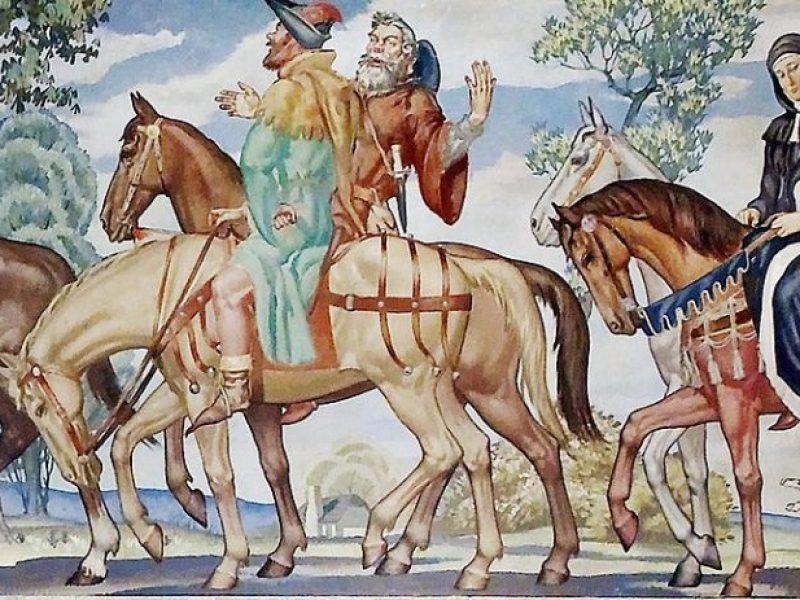
The pilgrimage route today
After the award in 1994, another award was added in 2004. Along with the Camino de Santiago, the pilgrimage route was also awarded a tribute from the Great Cultural Itinerary of Europe. And if you read below which countries, areas and places you will walk through on your Via Francigena, you will understand immediately why.
The route is over 2000 km long. You can travel it by bike, by car and, of course, by walking. The route passes through four countries and is divided into 86 stages of 25 km on average.
As we know by now, the route starts in England, in Canterbury. The country of England counts ‘only’ 1 stage. Because after that, you continue your journey in France. It is the beautiful white cliffs of Dover where the stages in France start. Then continue to northern France where the history of World War I plays a big part.
The Champagne region, beautiful Reims and through the Jura to the Alps. Where the imposing mountain peaks will lead you to the next country. And so you will imagine yourself in La Douce France for 785 km, 30 stages long.
Once you arrive in Switzerland, you will be accompanied by the beautiful mountains for 214 km. The beautiful Lake Geneva is of course not to be missed in this route. It is the historic great St Bernard Pass that helps you cross the border between Switzerland and Italy. And of course you can enjoy breathtaking views of the Alpine pass that gives you a mighty sense of adventure.
The last stages, 44, with a total of 1014 kilometres, you hike in beautiful Italy. You enter the country through the Apennines and continue into Umbria. Green fields, rolling hills, it’s just a sneak preview of beautiful Tuscany where vineyards and olive groves alternate with medieval villages like Lucca, San Gimignano and Siena.
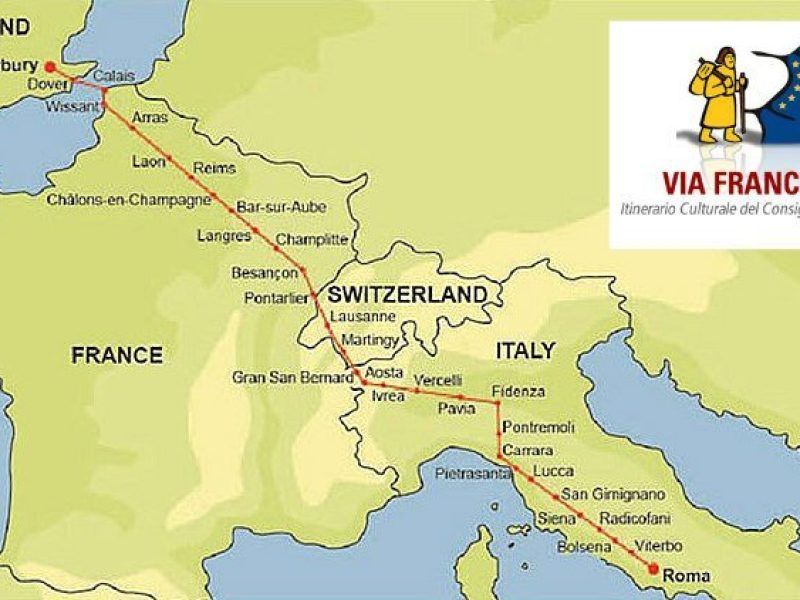
The very last kilometres of this pilgrimage route pass through the Lazio region where Rome is already beckoning you. The Via Francigena ends, after 2044 kilometres, in the middle of St Peter’s Square. An impressive place designed especially for pilgrims to give them a worthy welcome. And this square is just the beginning of this honourable greeting. Because after that, of course, it is time to enjoy the historic, vibrant and gastronomic city of Rome to round off your Via Francigena properly.
Even on this pilgrimage route, you can shorten stages, merge them or choose just a different path. After all, the expression Omnes viae Romam perducunt, or several roads lead to Rome, was born on this pilgrimage route. And thus totally lives up to its name.
The signage
In general, the Via Francigena is well signposted. Of course, there are always times when a diversion is signposted due to roadworks. Anything to improve the route. And it never hurts to have a GPS or a map during your walking holiday.
But it is good to know that the route is signposted differently in every country. In England, for instance, from Canterbury you have to follow the South Downs Way to Dover.
In France, the route has yet another name and turns into a more familiar GR route, namely the GR-145. Switzerland has again given it its own name, one for a long-distance route. There you follow the route 60 Via Francigena. Once you arrive in Italy, you will find signage designed by them. The ever recognisable pilgrim is interspersed with self-designed logos of regions and other local landmarks.
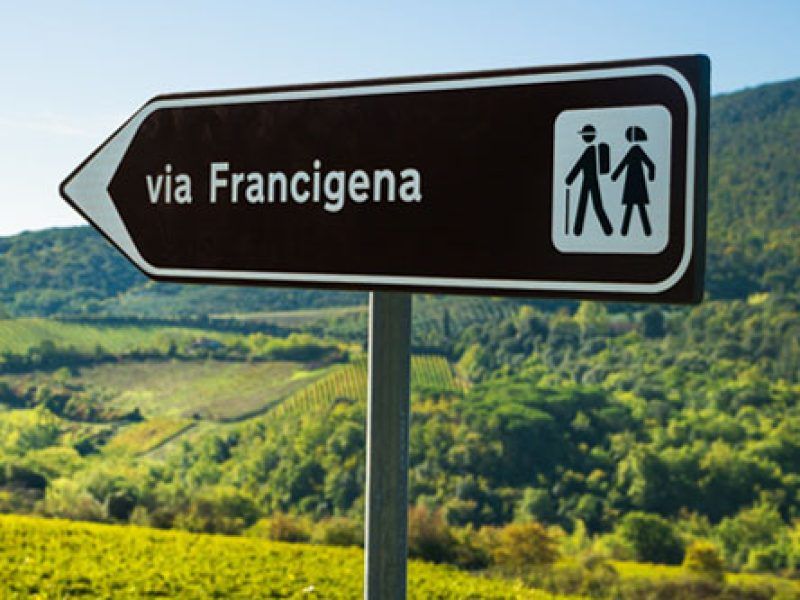
What do I take with me?
Good preparation is half the battle. Surprises are fun, but only if they are pleasant, especially when travelling. Preparing well and therefore avoiding these surprises only takes a little effort. In fact, it only gives you pleasure. And all the more you can enjoy your walking holiday.
To start with, take a good mood with you. Something everyone can take care of and (thankfully) doesn’t weigh much. In addition, another, golden tip; anything you can leave at home is a good thing. And in case you forgot something really important; you are not hiking in the uninhabited world, so there are shops you can still go to.
Water is essential. Keeping yourself hydrated is important. As is eating nutritious food so that you regain energy to walk the next kilometres and stages. Before you start a stage, always check carefully whether you will encounter provisions on the route during the day. If not, make sure you have extra food and drink during your walking trip on the Via Francigena.
You can drink water, but of course this can also fall from the sky. Fortunately, (we as Dutchies) are used to some water and wearing a rain coat or a poncho is not completely unknown. Also make sure you have a protective cover for your bag and that it does not get soaking wet. If you do not have a protective cover, make sure the poncho is large enough so that your bag fits under it.
Maps
Prepare well for the stages, routes and kilometres to be walked. Read up, look at maps, buy a booklet or browse the internet. This preliminary fun is sometimes as much fun as the journey itself. And with all the technology these days, you can also put the routes on your phone using offline maps or gps and gpx files. It’s great to hike in peace, without a network. But it’s pretty annoying when you need to take a moment to find your way.
Camera
Taking a ‘mental picture’ is, of course, always possible. But every now and then you still want to share all that beauty with others. Some are avid photographers and love to go out with their camera. The other takes beautiful pictures with his or her smartphone. Every now and then, don’t forget to capture the beautiful scenery you walk in for others. Or for yourself, so you can look back on it later with a smile.
Walking poles
This is a personal issue. Some cannot go out without them, while others prefer to hike without walking poles. In a mountain or hilly area, a walking pole can help. But on flat terrain, you often don’t need them and they take up ‘unnecessary space’. Should you want to buy walking poles, read this blog where we give you 10 tips.
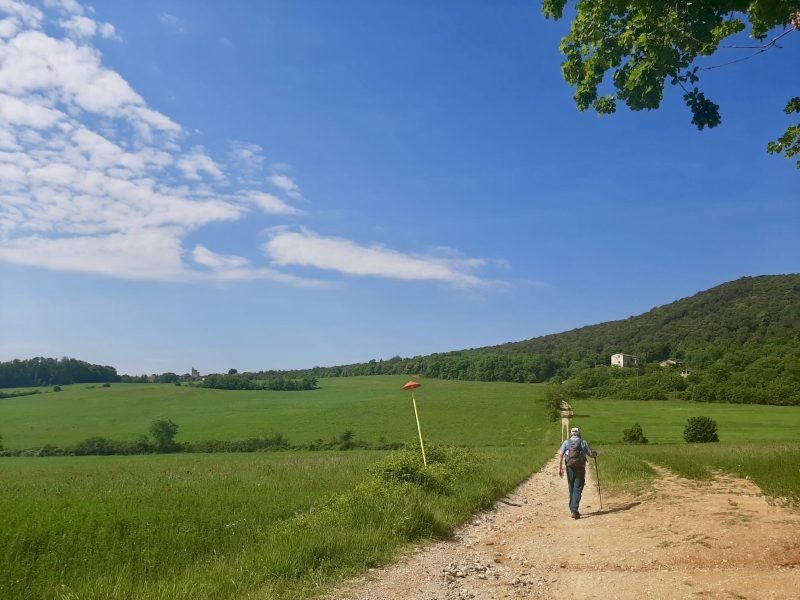
What clothes do I take with me?
Because the route goes through different countries, you will encounter many different types of weather. Besides, the weather is something we cannot ‘order’, and perhaps that is just as it should be. Setting off well prepared is half the battle and gives you endless pleasure. All the more you can therefore enjoy your pilgrimage route.
Good clothing is therefore very important. All depends on the season and the place where you will be hiking. But wear clothes that are comfortable, that keep you dry and warm, but also that don’t make you sweat too quickly. Wear layers so that, if necessary, you can put something on but also stretch it out again.
If you walk in a sunny or warm area. Then make sure you have enough protection. Not only sunscreen, but a hat or cap are then definitely recommendable.
Spring and autumn are the best travel times to hike the route. In spring, everything starts to blossom, gives a beautiful colour and it is pleasant and not too hot. This is also the case in autumn where you will be treated to the beautiful colours of autumn that are even better when the sun shines on it.
During this period, you will also meet fellow pilgrims. Not too many, but enough to sometimes have a chat, share stories or give each other tips. Finally, it is true that in this period more accommodations are open and they are only too happy to welcome you with a warm welcome.
Where to stay during the Via Francigena?
Whereas in France you stay in so-called albergues, in Italy you can spend the night in an agriturismo. Staying overnight during your Via Francigena can be done in various ways Real adventurers set off with a tent and look for a suitable campsite or other camping place. It is advisable to find out where there are camping facilities.
Others make grateful use of all the accommodation available along the way. Some old abbeys, monasteries and other beautiful buildings have been transformed into nice places to sleep and pilgrims are given a warm welcome. In addition, in these places you often meet other pilgrims and can share experiences and stories which really creates a special bond.
Of course, we are happy to search for these gems along the route for you. We select the accommodations with care, they are located near or not far from the route and offer you breakfast so that you can start a new stage in the morning with a filled stomach. We prefer a mix of (boutique) hotels, B&Bs and agritourisms, so you can taste the Italian atmosphere everywhere. (If possible, of course.) And be sure to let us know what wishes you have, so we can take them into account.
So also take into account special, regional holidays and other important events in the different countries. For example, Easter is an important holiday and early booking is essential. And in Italy there are often wine harvest festivals in autumn, in September and October. Highly recommended to experience this joyous celebration. But here again; make sure you book early to be sure of a place to sleep, so you can (roll over) into bed after a wine festival.
Obtaining the credential
As with a Camino to Santiago de Compostela, you can apply for a so-called pilgrim’s passport for this pilgrimage route in which you can put stamps. Each stamp marks a new milestone. And besides, these stamping points are often located in beautiful buildings such as churches, monasteries, abbeys or a local bar. These places alone will give you valuable memories. Not to mention the look of all those different kinds of stamps. A beautiful and precious souvenir that can be redeemed with a credential to pick up in Rome.
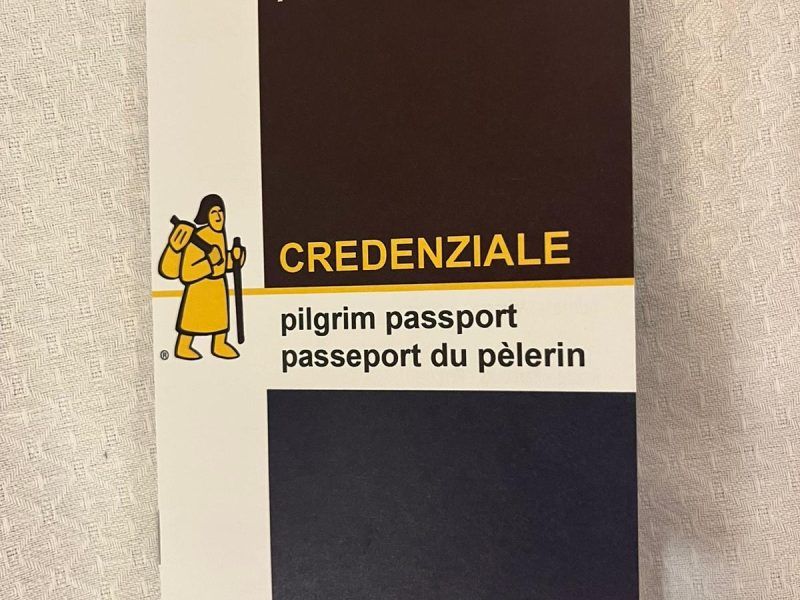
The Via Francigena, a pilgrimage route with an impressive history. A decent number of kilometres that run through 4 different countries and has plenty of stages to explore. Soak up the different cultures, enjoy the breathtaking landscapes, imagine yourself in the historical past and taste the local cuisines.
If you would like to follow in Sideric’s footsteps and hike in beautiful Tuscany, check out our 8-day hiking trip from Lucca to Siena. Or maybe you have another camino planned first anyway.
Feel free to contact us and we will be happy to help you organise your next walking or cycling holiday.
How long does it take to walk the Via Francigena from start to finish?
Walking the full Via Francigena from Canterbury to Rome covers nearly 2,000 km and takes around 90 to 100 days on average. Most pilgrims, however, choose to walk only a section of the route, often completing it in two to four weeks.
Which are the main highlights along the Via Francigena?
The route passes through four countries and offers diverse highlights, such as Canterbury Cathedral in England, the vineyards of Champagne and Burgundy in France, the Alps crossing at the Great St. Bernard Pass in Switzerland, and medieval towns like Siena and Lucca in Italy, before reaching St. Peter’s Basilica in Rome.
Do I need a credential or pilgrim passport for the Via Francigena?
Yes, it is recommended to carry a pilgrim credential (credenziale). This document records your journey with stamps from churches, hostels, and tourist offices along the way. It is required to access some pilgrim accommodations and to request the “Testimonium,” the certificate awarded upon arrival in Rome.


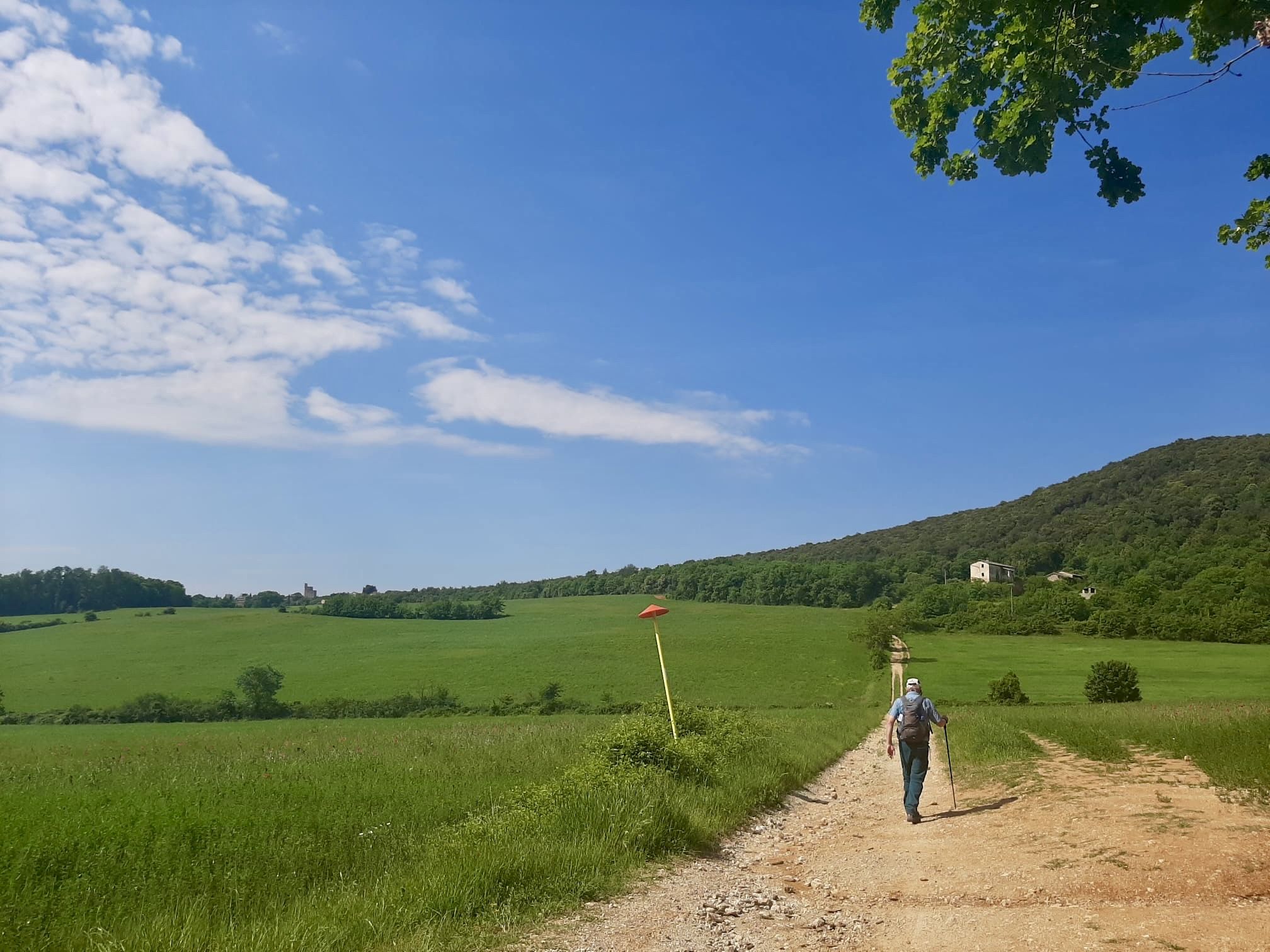
Comment (0)